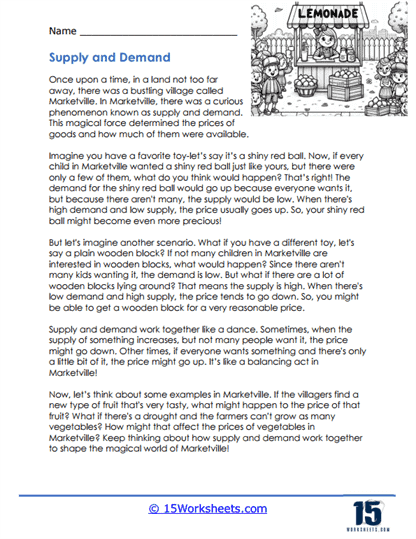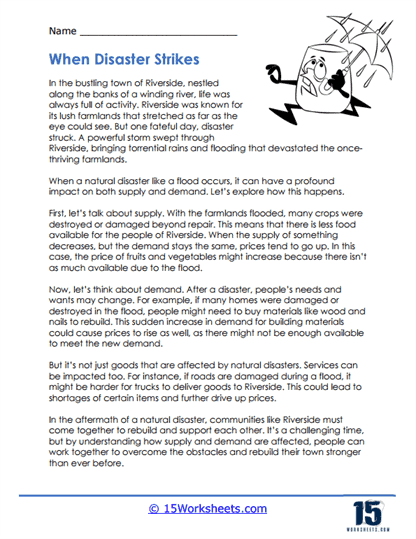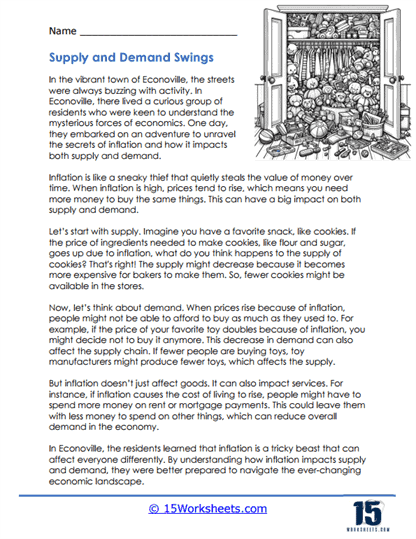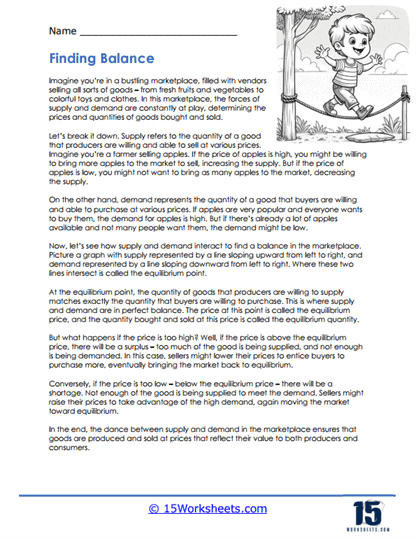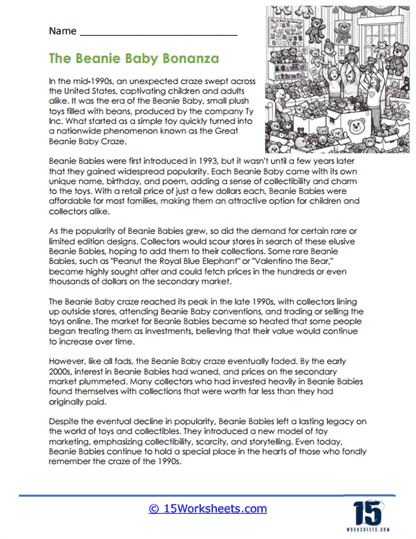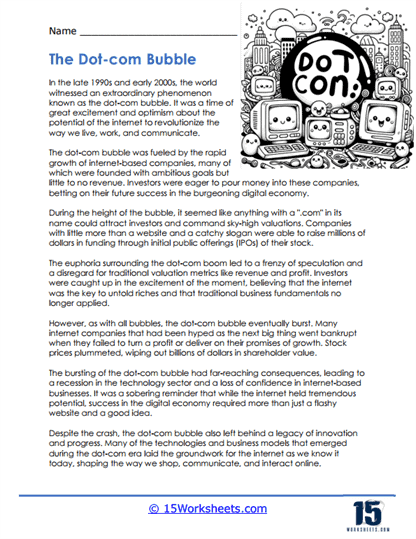Supply and Demand Worksheets
About These 15 Worksheets
These worksheets help students understand the foundational economic concept of supply and demand. These worksheets provide a variety of exercises that simulate real-world market situations, allowing students to visualize and calculate how different factors affect the availability and desire for products and services. By engaging with these worksheets, students develop a deeper comprehension of how markets operate and the dynamic relationship between producers and consumers.
Through a range of exercises, they help students develop a robust understanding of how markets function. This knowledge is not just academic; it empowers students with the economic literacy to navigate the marketplace effectively, both as consumers and as future professionals. Through continual practice, students can hone their analytical skills and apply economic reasoning to various aspects of their everyday lives, enhancing both their personal and professional decision-making processes.
Types of Exercises
Scenario Analysis – Worksheets often include hypothetical scenarios, such as a sudden increase in the demand for a product or a decrease in the supply of raw materials. Students analyze how these scenarios affect prices and quantity and learn to predict market reactions.
Price Elasticity Calculations – Exercises include calculating the price elasticity of demand or supply, which measures how responsive the quantity demanded or supplied is to a change in price. Students learn to differentiate between elastic and inelastic goods and services.
Role-Playing Activities – Some worksheets offer role-playing opportunities, where students must make decisions as either consumers or producers. These decisions revolve around how much to buy or sell given certain market conditions, helping students understand strategic decision-making.
Case Studies – Real-world case studies of particular markets, products, or services can be examined to understand supply and demand principles. Students analyze the factors that affected supply and demand and the outcomes of these shifts.
Matching and Multiple Choice Questions – Basic worksheets might include matching terms with their definitions and multiple choice questions to test students’ basic understanding of concepts like surplus, shortage, equilibrium price, and shifts in supply and demand curves.
Critical Thinking Questions – These questions challenge students to consider the broader implications of supply and demand, such as how government policies like price ceilings or floors can affect markets.
Improving Understanding
Practicing with supply and demand worksheets enhances a student’s ability to grasp the relationship between supply and demand by:
Building Economic Intuition – Regular practice allows students to develop an intuition for how changes in supply and demand affect market conditions. They start to recognize patterns and can more readily predict outcomes. Many supply and demand problems require mathematical calculations. By working through these problems, students improve their quantitative skills, which are essential for understanding and analyzing market trends.
Developing Critical Thinking – As students work through different market scenarios, they learn to think critically about how various factors affect supply and demand. This skill is valuable in making reasoned arguments and informed decisions in daily life. By examining real-world cases and scenarios, students learn to connect economic theory with the real world, which helps them understand the relevance of what they are learning.
Application in Daily Life
The concepts of supply and demand are not limited to economics classes; they are applicable in everyday life:
Consumer Awareness – Understanding supply and demand helps students become more informed consumers. They can make better purchasing decisions by considering how market forces affect the prices of the goods they buy.
Career and Business Insights – For those interested in entrepreneurship or business careers, understanding supply and demand is crucial for making strategic decisions such as pricing, marketing, and inventory management.
Personal Finance Management – Knowledge of supply and demand can influence personal finance decisions, like investing in stocks or real estate, as these markets are also governed by these principles.
Civic Engagement – An understanding of supply and demand can help individuals engage in civic discussions about government policies that affect the economy, such as taxes, subsidies, and import tariffs.
What Is the Concept of Supply and Demand?
The concept of supply and demand is a fundamental principle of economics that describes how the quantity of goods and services available (supply) and the desire of buyers for them (demand), determine the price and quantity of any given commodity or service in a market. It forms the cornerstone of a market economy and serves as a key predictor of the economic health and behavior of a society.
What is Supply?
Supply represents how much the market can offer of a particular good or service. It is based on the assumption that, all else being equal, the higher the price of a good, the more sellers will be willing to provide it. Supply is typically represented graphically by an upward-sloping line on a price-quantity graph, indicating that as the price increases, producers are willing and able to sell more.
Factors that can shift the supply curve, not just move along it, include technological innovations, changes in the cost of raw materials, taxes, subsidies, and changes in the number of sellers in the market. These factors can increase or decrease total supply, which can affect market equilibrium.
What is Demand?
Demand, on the other hand, represents how much of a good or service consumers are willing and able to purchase at various prices. The basic principle of demand is that, all else being equal, the lower the price of a good, the more people will demand it. Graphically, demand is represented by a downward-sloping line, indicating that as the price decreases, consumers will buy more of the good.
Factors that can affect demand include consumer preferences, price of related goods (substitutes or complements), income levels of consumers, expectations of future price changes, and the number of potential buyers. Changes in these factors can shift the demand curve.
The Equilibrium – Where Supply Meets Demand
The point where the supply and demand curves intersect is known as the market equilibrium. At equilibrium, the quantity supplied and quantity demanded are equal, and the market is stable. Prices tend to move toward the equilibrium level naturally due to the law of supply and demand. If the price is above equilibrium, a surplus occurs, leading producers to lower prices to clear the excess supply. Conversely, if the price is below equilibrium, a shortage occurs, leading producers to raise prices as consumers compete for the limited goods.
Why is this Concept Important?
Price Determination – Supply and demand dynamics are central to understanding why prices change and how they are set. This helps consumers and producers make informed decisions.
Resource Allocation – In a market economy, supply and demand help allocate resources efficiently. Resources are directed towards the production of goods and services that are most desired by consumers, as indicated by their willingness to pay.
Production and Investment Decisions – Businesses rely on their understanding of supply and demand to make production and investment decisions. Knowing the demand helps them decide how much to produce, while understanding supply conditions can affect decisions about how to produce.
Economic Indicators – Changes in supply and demand can signal shifts in the economy, which can guide policymakers. For example, a drop in demand could indicate an impending economic downturn.
Consumer and Producer Surplus – The concept helps explain how consumers and producers derive surplus from transactions. Consumers experience surplus when they purchase a good for less than they would have been willing to pay, and producers experience surplus when they sell a product for more than the minimum they would have accepted.
Policy Formulation – Governments use an understanding of supply and demand to formulate policies. They might implement taxes, subsidies, price floors, or ceilings to correct market imbalances and achieve social or economic objectives.


